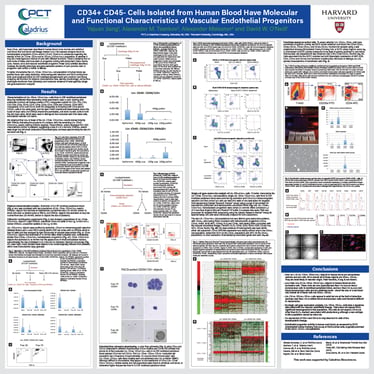
CD34+ CD45- Cells Isolated from Human Blood Have Molecular and Functional Characteristics of Vascular Endothelial Progenitors
Rare CD45- cells have been described in human blood, bone marrow and umbilical cord blood that lack blood cell lineage markers (Lin-) but express antigens (CD34 and/or CD133) associated with hematopoietic (blood cell) progenitors. This is in contrast to typical hematopoietic progenitors, which express CD45. There is no consensus regarding the identity of this Lin- CD45- CD34 and/or CD133+ (CD34/133+) population, or whether it may be a heterogeneous mixture of cells with different functions. Characterization of this cell population is of considerable interest, since there is evidence that at least some of these cells have stem or progenitor activity, with pluripotent (cells that can regenerate any tissue in the body) and endothelial (blood vessel) progenitor activities described. Another possibility is that the Lin- CD45- CD34/133+ population may contain very early hematopoietic stem or progenitor cells that have not yet begun to express CD45.
To better characterize the Lin- CD45- CD34/133+ cell population in human blood, PCT scientists purified these cells using elutriation, immunomagnetic selection and FACS sorting from both adult peripheral blood (G-CSF mobilized leukapheresis) and umbilical cord blood, analyzing cell fractions for physical characteristics (size, density, morphology) and cell surface phenotype (multicolor flow cytometry). In addition, single cells from mobilized peripheral blood were sorted into 384-well plates at PCT for gene expression analysis (targeted RNA sequencing) at Harvard University to look for molecular evidence of cell type and for evidence of heterogeneity within the Lin- CD45- CD34/133+ cell population. Functional studies were also performed at PCT on cord blood cells FACS sorted into 4 populations based on CD34 and CD45 expression (CD45+ CD34-, CD45+ CD34+, CD45- CD34- and CD45- CD34+).
The results of this work showed that:
- Over 90% of Lin- CD45- CD34/133+ objects in human blood are extracellular vesicles and not cells. All or almost all of these objects are CD34+ CD133-. They are most likely of blood vessel origin. Their function, if any, is not known.
- Less than 10% of Lin- CD45- CD34/133+ objects in human blood are live nucleated cells. These cells are very rare (typically less than 1 in 100,000 blood mononuclear cells in mobilized peripheral blood, and less than 1 in 10,000 cord blood mononuclear cells) and are relatively small – about the size of a red blood cell. Almost all of these cells are CD34+ CD133-.
- Lin- CD45- CD133+ CD34- cells also appear to exist but are extremely rare (at the limit of detection, perhaps less than 1 in 10 million blood mononuclear cells) and were therefore difficult to characterize.
- By single cell gene expression analysis, Lin- CD45- CD34+ cells have a molecular signature associated with endothelial (blood vessel) cells. There does not appear to be significant heterogeneity in this population. The cells do not express CD133 and do not appear to express markers associated with pluripotency other than KLF4. Based on sample size, an extremely rare Lin- CD45- subtype that might express such markers could not be completely ruled out.
- Co-expression of CD34 and CD133 was only observed in cells of the hematopoietic lineage (CD45+ cells).
- Endothelial progenitor activity (the ability to form new blood vessels) in human umbilical cord blood, as measured by a well-established assay (ECFC, or Endothelial Colony Forming Cell assay) using FACS sorted cells, is enriched only in the CD45- CD34+ cell population. This activity is also observed in adult human peripheral blood.
Study authors:
Yajuan Jiang, PCT, a Caladrius Company, Allendale, NJ
Alexander M. Tsankov, Harvard University, Cambridge, MA
Alexander Meissner, Harvard University, Cambridge, MA
David W. O’Neill, PCT, a Caladrius Company, Allendale, NJ
Media Contact Info:
- Name: Luc St-Onge, Ph.D.
- Email: press@rm.minaris.de
